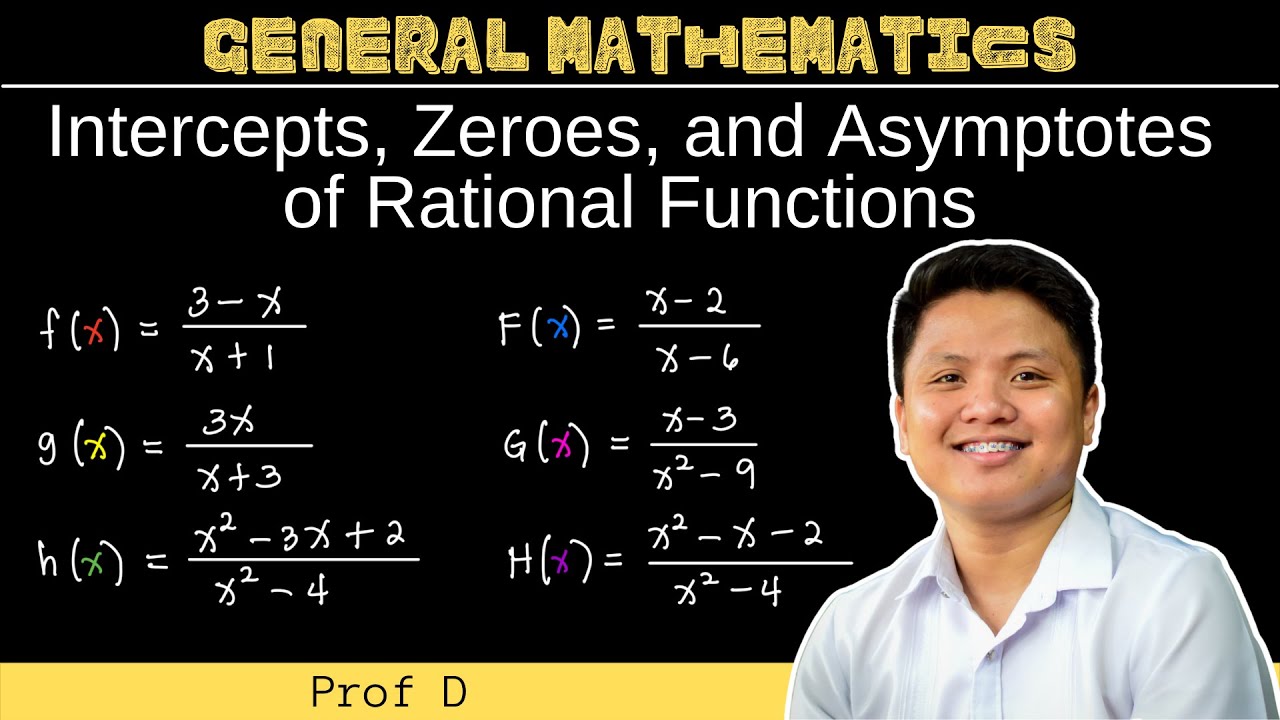Rational Function (Domain, x & y - Intercepts, Zeros, Vertical and Horizontal Asymptotes and Hole)
Summary
TLDRThis tutorial video teaches viewers how to analyze rational functions by determining their domain, x-intercepts, y-intercept, zeros, vertical and horizontal asymptotes, and holes. The instructor uses step-by-step examples to illustrate the process of finding these characteristics, starting with defining the domain as all real numbers except the zeros of the denominator. The video then demonstrates how to find x and y-intercepts by setting y to zero and x to zero respectively, and explains how to identify zeros and asymptotes based on the degrees of the numerator and denominator. The concept of holes, or removable discontinuities, is also covered, showing how they occur when there's a common factor in the numerator and denominator. The tutorial is designed to provide a comprehensive understanding of rational functions.
Takeaways
- 📘 A rational function is defined as the ratio of two polynomial functions.
- 🚫 The domain of a function includes all real numbers except the zeros of the denominator.
- ✖️ To find the x-intercept, set y to zero and solve for x, ensuring x is within the domain.
- 🔍 The y-intercept is found by setting x to zero and solving for y.
- 🔢 The zeros of a rational function are the values of x that make the function equal to zero, considering the domain restrictions.
- 📉 Vertical asymptotes occur at values of x that make the denominator zero, but are not included in the domain.
- 📈 The horizontal asymptote is determined by comparing the degrees of the numerator and the denominator, and can be none if the degree of the numerator is greater.
- 🕳 A hole, or removable discontinuity, is present when there is a common factor in the numerator and denominator, leading to a discontinuity at the value of x that makes the common factor zero.
- 🔄 The process involves factoring the numerator and denominator to identify intercepts, asymptotes, zeros, and holes.
- 📚 The tutorial provides a systematic approach to analyzing rational functions, emphasizing the importance of domain considerations.
Q & A
What is a rational function?
-A rational function is any function that can be written as the ratio of two polynomial functions, with the numerator and the denominator being polynomials.
How do you find the domain of a rational function?
-The domain of a rational function is the set of all real numbers except for the values that make the denominator zero.
What is an x-intercept and how do you find it?
-An x-intercept is a point where the graph of the function crosses the x-axis, which means the y-value is zero. To find it, set y to zero and solve the equation for x.
What is a y-intercept and how is it determined?
-A y-intercept is the point where the graph of the function crosses the y-axis, which occurs when x is zero. Determine it by substituting x with zero in the function and solving for y.
What are the zeros of a rational function?
-The zeros of a rational function are the values of x that make the function equal to zero. They are typically found by setting the function to zero and solving for x.
How do you determine if a rational function has a vertical asymptote?
-A rational function has a vertical asymptote at values of x that make the denominator zero but are not included in the domain of the function.
What is a horizontal asymptote and how is it found?
-A horizontal asymptote is a horizontal line that the graph of the function approaches as x approaches infinity or negative infinity. It is found by comparing the degrees of the numerator and the denominator.
What is meant by a 'hole' in a rational function?
-A 'hole' in a rational function refers to a removable discontinuity, which is a point where the function is not defined due to a common factor in the numerator and denominator that can be canceled out.
How do you find the coordinates of a 'hole' in a rational function?
-To find the coordinates of a 'hole', identify the common factor in the numerator and denominator, set it equal to zero to find the x-value, and then substitute this x-value back into the function to find the y-value.
What is the significance of the degrees of the numerator and denominator in determining the horizontal asymptote?
-The degrees of the numerator and denominator determine the horizontal asymptote as follows: if the degree of the numerator is less than the degree of the denominator, the asymptote is y=0; if they are equal, the asymptote is the ratio of the leading coefficients; if the degree of the numerator is greater, there is no horizontal asymptote.
Outlines

Этот раздел доступен только подписчикам платных тарифов. Пожалуйста, перейдите на платный тариф для доступа.
Перейти на платный тарифMindmap

Этот раздел доступен только подписчикам платных тарифов. Пожалуйста, перейдите на платный тариф для доступа.
Перейти на платный тарифKeywords

Этот раздел доступен только подписчикам платных тарифов. Пожалуйста, перейдите на платный тариф для доступа.
Перейти на платный тарифHighlights

Этот раздел доступен только подписчикам платных тарифов. Пожалуйста, перейдите на платный тариф для доступа.
Перейти на платный тарифTranscripts

Этот раздел доступен только подписчикам платных тарифов. Пожалуйста, перейдите на платный тариф для доступа.
Перейти на платный тарифПосмотреть больше похожих видео

Graphing Rational Functions Step-by-Step (Complete Guide 3 Examples)

Intercepts, Zeroes, and Asymptotes (Horizontal/Vertical) of Rational Functions | General Mathematics

Graphing Rational Functions

Asimtot Datar, Asimtot Tegak dan Asimtot Miring Fungsi Rasional Matematika Peminatan Kelas XII

Fungsi Rasional Bentuk 1 (Domain, Range, Cara Menggambar)

Relasi dan Fungsi Matematika Kelas 10 • Part 27: Soal Fungsi Rasional Bentuk 3 - Kuadrat / Linear
5.0 / 5 (0 votes)
